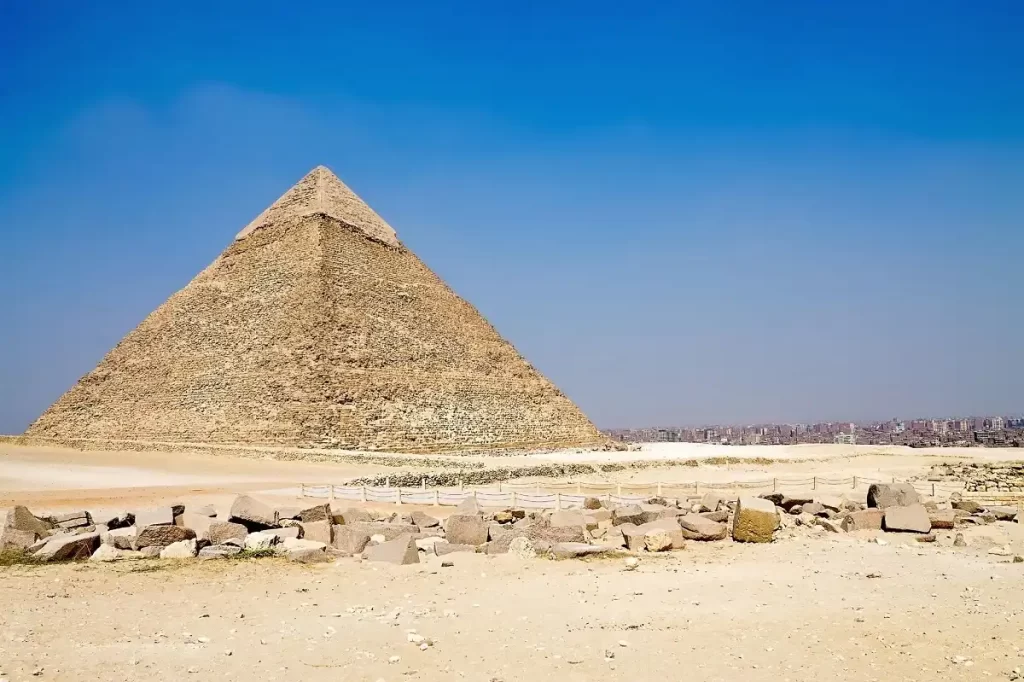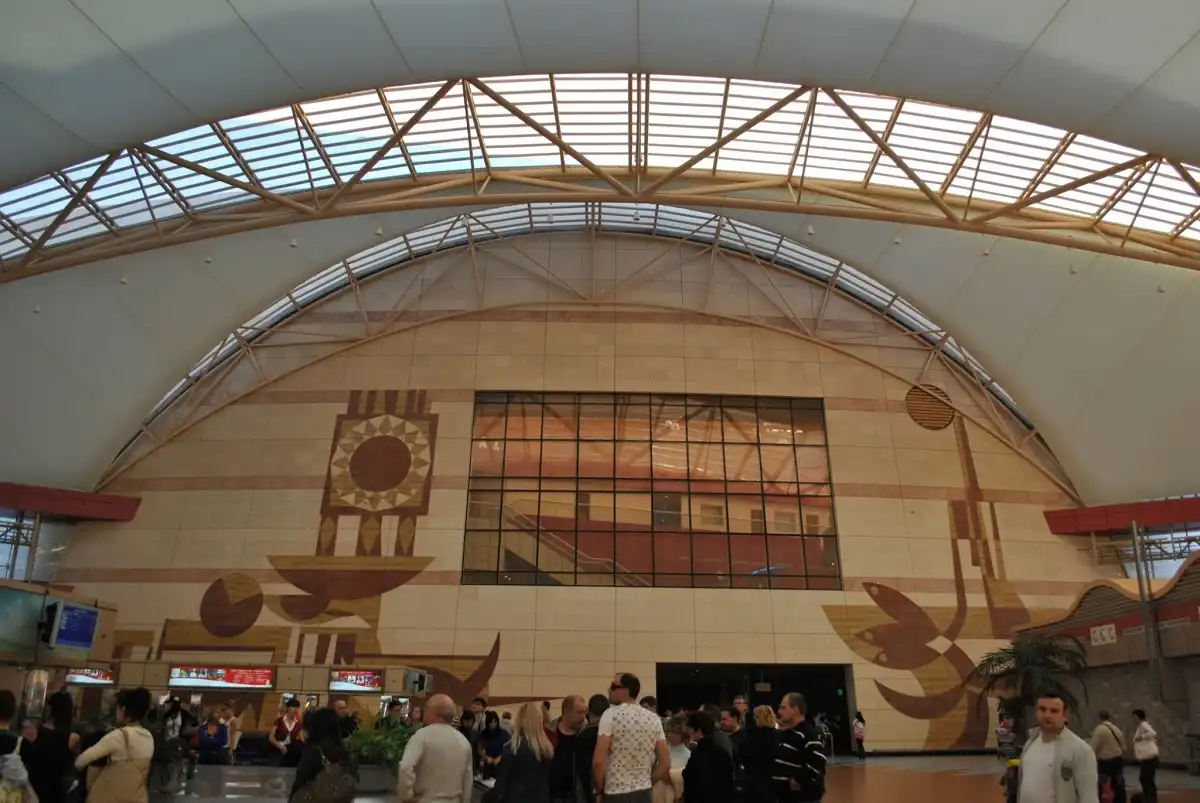
The Great Pyramid
[ez-toc]
The Great Pyramid of Khufu
The Great Pyramid of Giza is one of the heavenly structures that can genuinely demonstrate the intelligence and tenacity of the Human Race. It goes beyond our current grasp of art and science to a completely new level of comprehension. This article’s major goal is to provide every traveler and scholar with all the facts and information they might possibly need regarding the Pyramid of Khufu, also known as the Pyramid of Cheops. This essay was prepared by a highly skilled team of Egyptologists, tour operators, and guides who are extremely informed about the fabled Giza pyramid. When men started to take charge of their own fate, a magnificent monument was built to serve as a living reminder of the strength and wisdom of the ancient Egyptians. The Great Pyramid of Giza is one landmark that takes art & science to new heights. There are numerous buildings throughout the world that genuinely demonstrate the intelligence and commitment of the Human Race. The pyramid had religious significance because it was a duplicate of the primordial mound where the universe was created by the creator god Amun. It was a faithful reflection of the social structure of the ancient Egyptian community. From tourists to archaeologists to scientists, the Giza Pyramid has the power to captivate everyone’s attention.
History
The Pyramid, also known as the pyramid of “Cheops” by the Greeks who recorded their visits centuries later, was built by Pharaoh Khufu in the Fourth Dynasty around 2560 BC during the old kingdom (2686-2181 BC) to serve as his final resting place. It is the first of three Pyramids built during Egypt’s old kingdom. In 1979, UNESCO included the Memphis region’s ancient remains alongside the Pyramids of Giza, Saqqara, Dahshr, Ab Ruwaysh, and Abr as a single World Heritage site.
The 4th dynasty pharaohs are credited with building the pyramids because they were able to use their abundant resources, including economic prosperity, political stability, and a large and densely populated nation. Sneferu, the father of Khufu, was the first pharaoh to discover this. When Khufu took control, he began his construction of this pyramid layout. Because there were no other noteworthy structures nearby to compete for attention and because Khufu’s mother, Hetepheres I (2566 BCE), was buried there, he decided on Giza as the location for his necropolis.
The great pyramid of Khufu was dated using a variety of techniques, including historical chronology, and radiocarbon dating, which was able to precisely pinpoint Khufu’s past, and the great pyramid itself, which dates to between 2700 and 2500 BC. The massive Khufu pyramid is well-documented by several eminent historians, including Herodotus, a Greek historian who was among the first important writers to describe it in detail in the fifth century BC. Between 60 and 56 BC, the ancient Greek historian Diodorus Siculus had the opportunity to travel to Egypt, where he recorded a wealth of information on the country’s history, geography, customs, and monuments, including the Great Pyramid. After visiting Egypt in 25BC, the Greek traveler, historian, and philosopher claimed that monarchs were interred in the pyramids. In the first century AD, the Roman author Pliny the Elder endeavored to comprehend the construction of the huge pyramid in his writings. Many academics and historians recorded everything related to the great pyramid during the Greek and Coptic civilizations.
The Abbasid Caliph Al-Ma’mun (786–833) is credited for tunneling through the structure’s side in 820 AD, discovering the rising tube and all of its connected chambers. In order to learn more about the pyramid’s mysteries and wonders, many Islamic historians and academics, such Ass Al-Maqrizi (1364–1442) and Arab polymath Abd al-Latif al–Baghdadi (1163–1231), conducted extensive research on it. On July 21, 1798, during the Battle of the Pyramids, Napoleon Bonaparte and his French army conquered Cairo and entered the Great Pyramid of Khufu.
Location
On the bank of the Nile, King Khufu’s pyramid is situated alongside the renowned Giza pyramid complex at the precise junction of the longest latitude and longitude lines. The coordinates of the Great Pyramid of Giza are 29°58′45′′N 31°08′03′′E. The Great Sphinx is situated next to Khafre’s valley temple, south of the Great Pyramid.
Facts
The oldest and only one of the Seven Wonders of the Ancient World that is still completely intact is the great pyramid of Giza, also known as the Pyramid of Khufu or the Pyramid of Cheops. The old name for it was “Akhet Khufu,” which translates to “Khufu’s Horizon.” In the 26th century BC, it served as the tomb of the fourth dynasty’s Pharaoh Khufu. Before the Lincoln Cathedral in England was built in 1311 AD and the Eiffel Tower in Paris, France, was finished in 1889 AD, it held the record for the tallest man-made structure on Earth for more than 3,800 years.
The great pyramid was built by Khufu’s vizier, Heminuu, over the course of 20 years using 2.3 million limestone blocks, each weighing 2.5 tonnes, for a total mass of 5.9 million tonnes, plus mortar and some granite. On a foundation that is 230.3 (756 ft) long, it rises to a height of 146.6 m (481 ft), or 280 cubits at the time, and 138.5 m (454 ft), which is its modern height. The Khufu pyramid has a volume of 2.6 million m3 (92 million cu ft). The sides of the pyramid rise at an angle of 51°50’40” and face the four cardinal directions of the compass. There are three known rooms inside the great pyramid of Giza in addition to the gid emptiness. All the numbers above prove how it is a true living Miracle of pure genius engineering, precise architectural Skill, and a true sight to behold next to the other pyramids of Giza.
King Khufu
King Khufu, whose birth name was Khnum-Khufu, was the second Pharaoh of the Fourth Dynasty of the Old Kingdom (2589–2566 BC). The 26th century B.C. saw the coronation of Khufu, who succeeded his father Sneferu as king. According to ancient Egyptian and Greek historians, Khufu ruled for 50 or 63 years, however, many contemporary academics believe he may have reigned for between 23 and 46 years. Due to his pyramid in the Giza necropolis, Khufu’s name will live on forever in history. The only entirely intact statue of the king is a three-inch-tall ivory sculpture discovered in Abydos in 1903 and kept in the opulent Egyptian museum. The mummified body of King Cheops, or Khufu, has never been found, as it has been stolen from the Great Pyramid at some point in time.
The Construction of the Great Pyramid of Giza
The great pyramid’s construction methods are what really set it apart from other structures of its kind. While some theories claimed that slave labor was used, this was disproven because the critical path analysis techniques and management dynamics were used to manage a workforce that peaked at about 100,000 skilled workers working rotating shifts and was organized into teams and a hierarchy at its peak. The building required the usage of about 5.5 million tonnes of limestone, 8,000 tonnes of granite, and 500,000 tonnes of mortar. White limestone from Tura was used for the casing and granite blocks weighing up to 80 tonnes from Aswan were utilized for the King’s Chamber structure. White limestone that gave the pyramid its flawless, heavenly appearance was removed throughout the years to make way for forts and mosques all over Cairo. A unique block composed of shiny material, such as gold or electrum, was placed on top of the great pyramid once it was built.
The construction method for the pyramids is a crucial and much-contested topic, but many historians and researchers concur that it involved enclosing and sloping embankments of brick, sand, and dirt that were expanded in height and length as the pyramid rose. Rollers, sleds, and levers were used to move the limestone stone blocks up the ramp. You may read more about the construction of the Pyramids.
Interior of the Great Pyramid
There are numerous fringe and unconventional theories that speculate about the great pyramid’s interior. It consists of the tombs for Khufu’s family and court, the King’s burial chamber, the Queen’s burial chamber, a mortuary temple made up of two mortuary temples—one close to the pyramid and the other near the Nile—joined by a causeway, as well as the big void, smaller “satellite pyramid,” and five submerged solar barges. All of these structures are enclosed by a sturdy limestone wall. Inside the pyramid, there are three known chambers. The first is the king’s chamber, which is entirely made of granite and contains only a rectangular granite sarcophagus. On top of the king’s chamber are five rooms known as relieving chambers, and in the space between them is a limestone beam. The king’s sarcophagus is made of a single piece of hollowed-out granite, is completely empty, and is positioned at the exact Center of the great pyramid. Its internal dimensions are 198 cm (6.50 feet) by 68 cm (2.23 feet), its external dimensions are 228 cm (7.48 feet) by 98 cm (3.22 feet) and its height is 105 cm (3.44 feet). The entrance to the shaft was covered with limestone to conceal the opening, and a succession of enormous granite boulders was used to wall off the burial chamber.
There is an incomplete underground room whose use is unknown, as well as several so-called “air shafts” that extend out from the upper chambers. These pressure-relieving chambers were designed to divert the intense pressure from the King’s vast chamber and absorb it.
Two slender shafts in the north and south walls, which assisted in lifting the king’s spirit to the heavens, are located above the floor and appear to be aligned with the stars or specific regions of the northern and southern skies. The grand gallery, which is 8.6 meters (28 feet) high and 46.68 meters (153.1 feet) long, is a perfect example of stonemasonry. It supports a corbelled vault at an angle of about 26 degrees, peaking at about 30 degrees, and has corbelled arch stacks of stones on each subsequent layer with a slight overhang until the structure meets at the high point, which gives the grand gallery a little extra impact.
The queen’s chamber, where the pharaoh’s wife was held, has a similar design to the king’s chamber with a few minor differences. The third one is the Grand Gallery, which leads to the royal burial chambers. It is 64.68 m (153.1 ft) long and 8.6 m (28 ft) high, and its walls are made entirely of large granite slabs without any carvings, paintings, relics, or other ornamentation.
The Pyramid’s Complex
On the eastern side of the pyramid complex is where the pyramid’s temple was constructed. Its dimensions are 40 meters (130 feet) east to west and 52.2 meters (171 feet) north to south. It comprises of a sizable courtyard with a rectangular shape and a black basalt surface. With time, the temple complex has nearly completely vanished. The King’s burial chamber, which is still in the best condition in this pyramid, is accessible from the mortuary temple. The three lesser pyramids, which were built to honor Khufu’s mother Hetepheres I, his wives Meritites I, and Henutsen, are in considerably better shape.
Khufu is two enormous, rectangular stone-lined trenches on the southern side of the pyramid that once held totally disassembled boats. One of which was taken apart and rebuilt. The Grand Egyptian Museum is home to what is known as the Khufu solar boat. The length of this solar boat is 43.3 meters (142 feet), and it was built from 1,224 individual parts that were connected by ropes.
Mysterious facts about the Pyramid
The great pyramid continues to be riddled with mysteries that have baffled countless people, such as the Big Void above the Grand Gallery which was discovered in 2017 by a team of Japanese researchers utilizing muon radiography and measuring 30 meters (98 feet) in length. The cavity’s function is still a mystery. The pyramid has been associated with bizarre hypotheses that claim it may have come from “the lost city of Atlantis” or possibly come from another planet. The Orion correlation theory, which claims that the pyramids were a precise reflection of Orion’s belt, Leo’s constellation, and the milky way, has been heavily debated by the scientific community, which has argued that the pyramids may be older than what is thought to be and that their purpose may entirely be different from what is currently understood.



